RSK 80004: Perth Stadium Project Risk and Due Diligence Report
VerifiedAdded on 2022/11/18
|13
|2822
|262
Report
AI Summary
This report provides a detailed analysis of the Perth Stadium project, focusing on risk assessment, vulnerability assessment, and due diligence processes within the context of project management. It examines the challenges faced during the construction of the stadium, including delays, cost overruns, and the impact of various threats. The report identifies critical vulnerabilities, such as cost and time constraints, and explores the application of vulnerability assessment in infrastructural development. It also discusses the importance of due diligence in mitigating risks and ensuring project success, highlighting the significance of factors like project planning, stakeholder management, and the selection of assessment criteria. The report offers solutions to potential risks, emphasizing the importance of effective communication, strategic planning, and precautionary measures in large construction projects. It also includes a threat barrier diagram and a ranking of vulnerabilities, providing a comprehensive overview of the risk management strategies implemented for the Perth Stadium project. The report concludes with a discussion on risk avoidance and control mechanisms as essential for successful project completion.
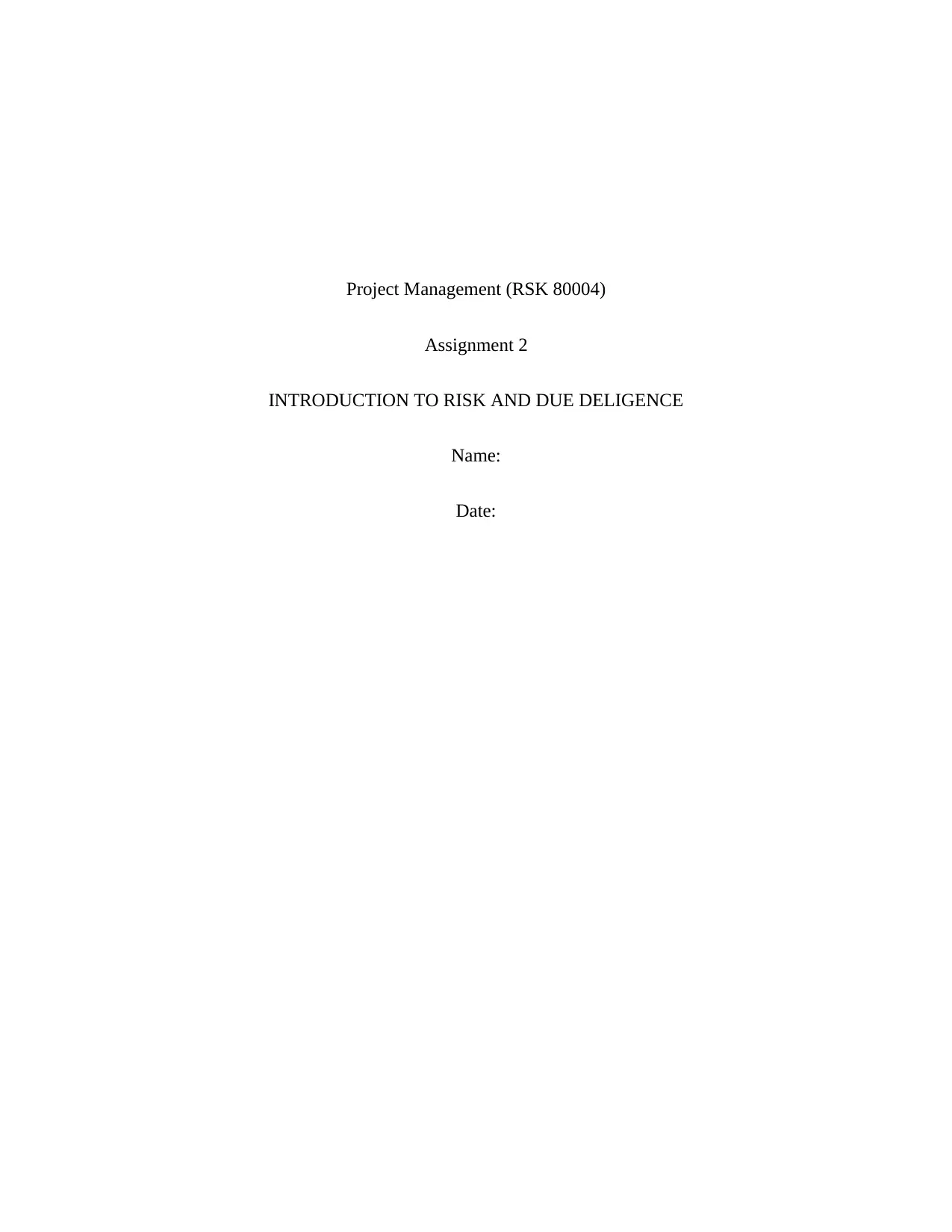
Project Management (RSK 80004)
Assignment 2
INTRODUCTION TO RISK AND DUE DELIGENCE
Name:
Date:
Assignment 2
INTRODUCTION TO RISK AND DUE DELIGENCE
Name:
Date:
Paraphrase This Document
Need a fresh take? Get an instant paraphrase of this document with our AI Paraphraser
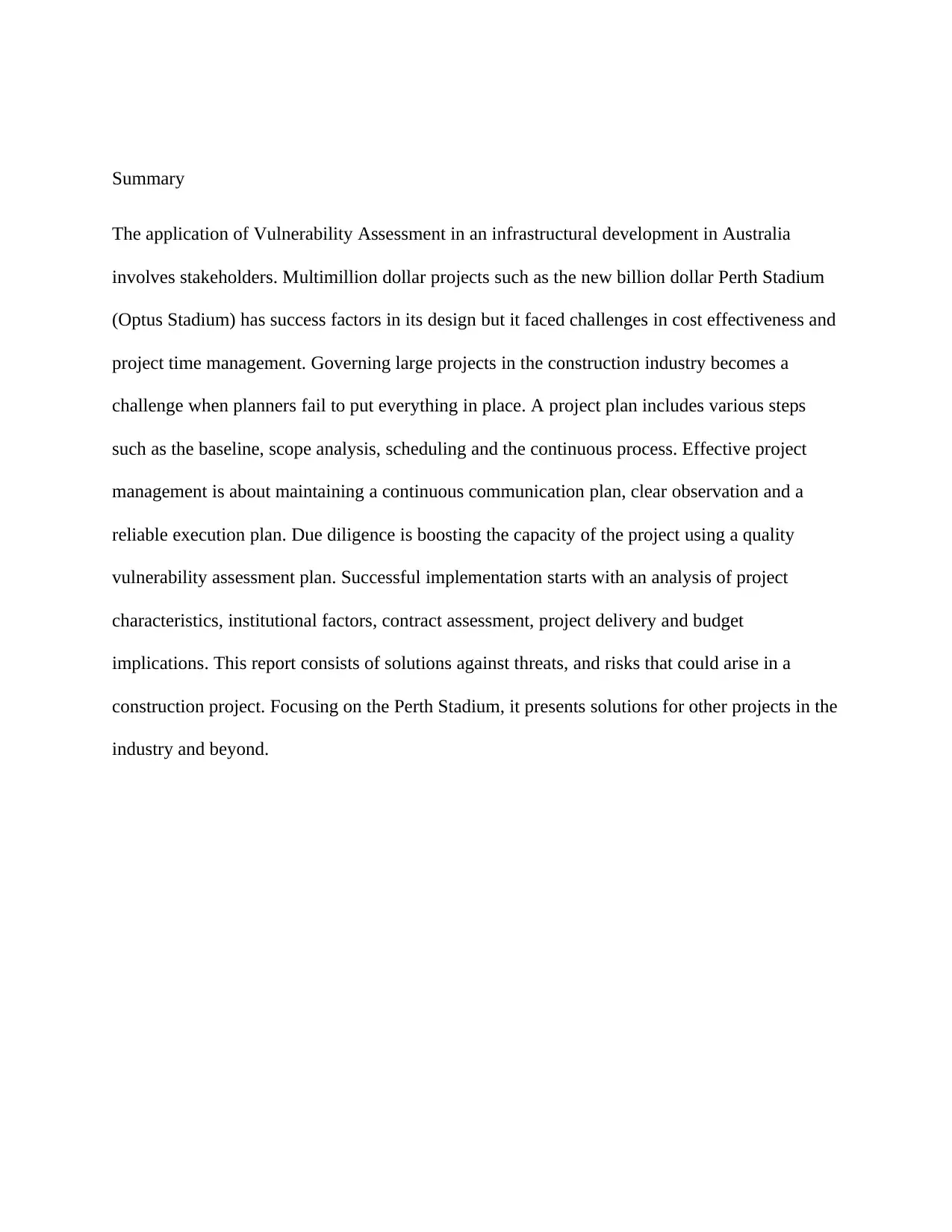
Summary
The application of Vulnerability Assessment in an infrastructural development in Australia
involves stakeholders. Multimillion dollar projects such as the new billion dollar Perth Stadium
(Optus Stadium) has success factors in its design but it faced challenges in cost effectiveness and
project time management. Governing large projects in the construction industry becomes a
challenge when planners fail to put everything in place. A project plan includes various steps
such as the baseline, scope analysis, scheduling and the continuous process. Effective project
management is about maintaining a continuous communication plan, clear observation and a
reliable execution plan. Due diligence is boosting the capacity of the project using a quality
vulnerability assessment plan. Successful implementation starts with an analysis of project
characteristics, institutional factors, contract assessment, project delivery and budget
implications. This report consists of solutions against threats, and risks that could arise in a
construction project. Focusing on the Perth Stadium, it presents solutions for other projects in the
industry and beyond.
The application of Vulnerability Assessment in an infrastructural development in Australia
involves stakeholders. Multimillion dollar projects such as the new billion dollar Perth Stadium
(Optus Stadium) has success factors in its design but it faced challenges in cost effectiveness and
project time management. Governing large projects in the construction industry becomes a
challenge when planners fail to put everything in place. A project plan includes various steps
such as the baseline, scope analysis, scheduling and the continuous process. Effective project
management is about maintaining a continuous communication plan, clear observation and a
reliable execution plan. Due diligence is boosting the capacity of the project using a quality
vulnerability assessment plan. Successful implementation starts with an analysis of project
characteristics, institutional factors, contract assessment, project delivery and budget
implications. This report consists of solutions against threats, and risks that could arise in a
construction project. Focusing on the Perth Stadium, it presents solutions for other projects in the
industry and beyond.
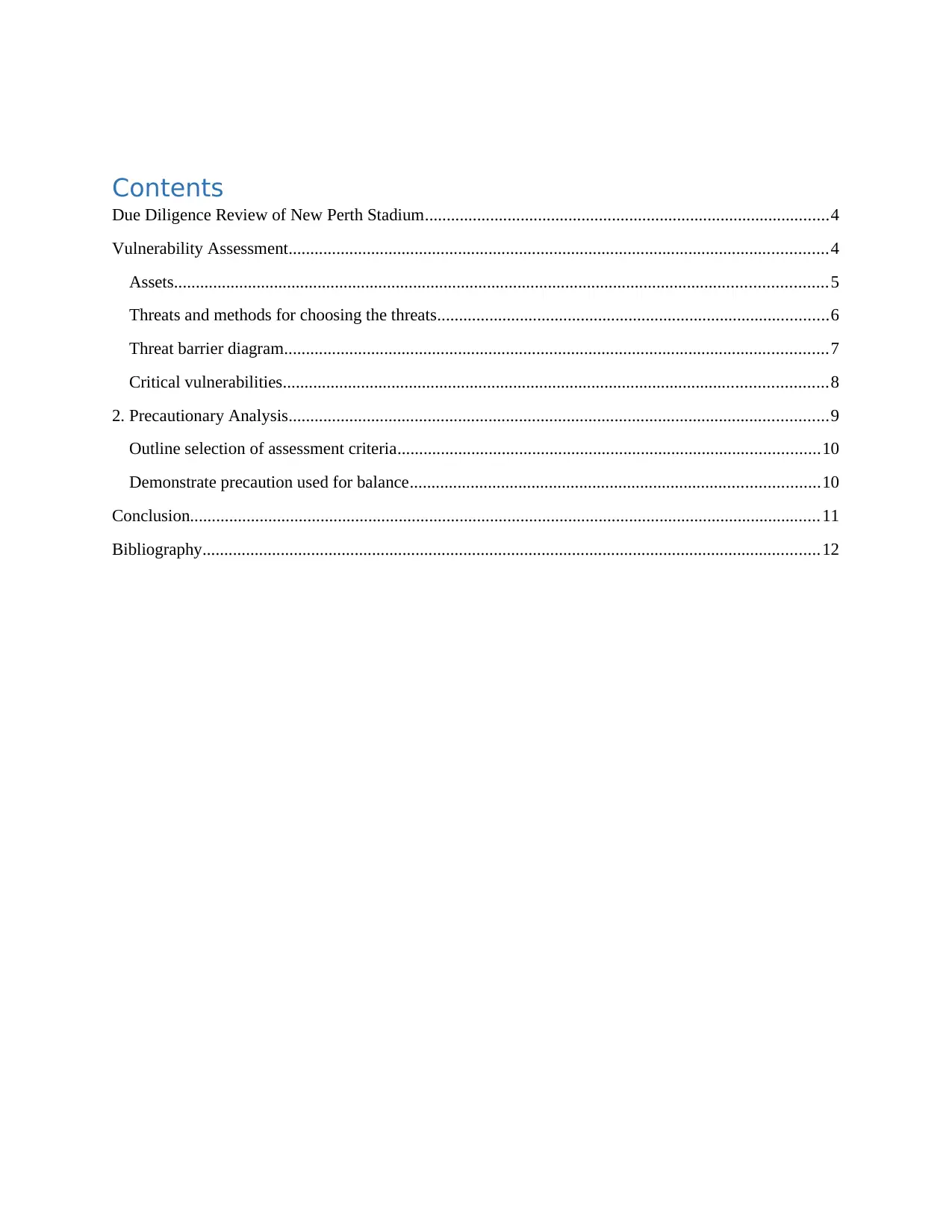
Contents
Due Diligence Review of New Perth Stadium.............................................................................................4
Vulnerability Assessment............................................................................................................................4
Assets......................................................................................................................................................5
Threats and methods for choosing the threats..........................................................................................6
Threat barrier diagram.............................................................................................................................7
Critical vulnerabilities.............................................................................................................................8
2. Precautionary Analysis............................................................................................................................9
Outline selection of assessment criteria.................................................................................................10
Demonstrate precaution used for balance..............................................................................................10
Conclusion.................................................................................................................................................11
Bibliography..............................................................................................................................................12
Due Diligence Review of New Perth Stadium.............................................................................................4
Vulnerability Assessment............................................................................................................................4
Assets......................................................................................................................................................5
Threats and methods for choosing the threats..........................................................................................6
Threat barrier diagram.............................................................................................................................7
Critical vulnerabilities.............................................................................................................................8
2. Precautionary Analysis............................................................................................................................9
Outline selection of assessment criteria.................................................................................................10
Demonstrate precaution used for balance..............................................................................................10
Conclusion.................................................................................................................................................11
Bibliography..............................................................................................................................................12
⊘ This is a preview!⊘
Do you want full access?
Subscribe today to unlock all pages.

Trusted by 1+ million students worldwide
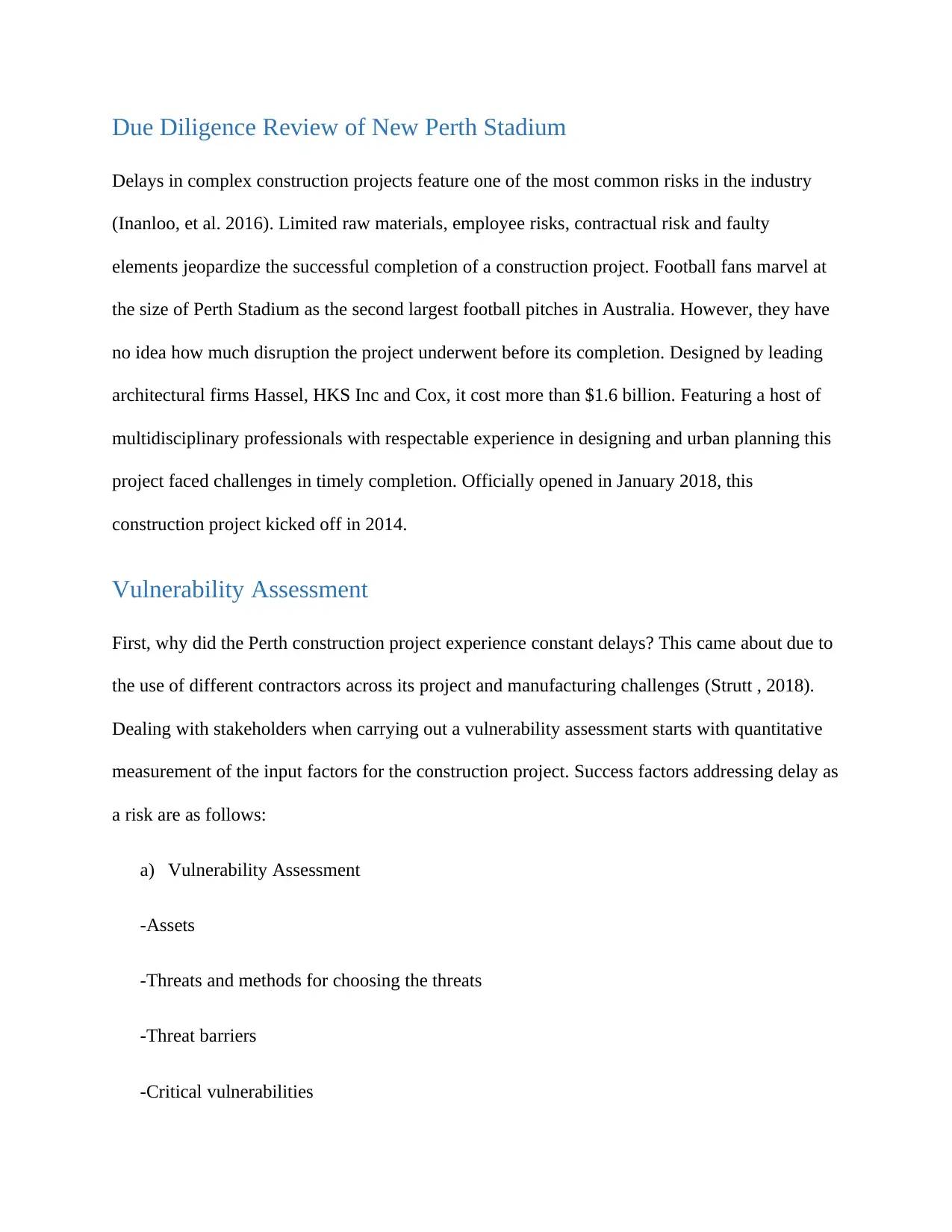
Due Diligence Review of New Perth Stadium
Delays in complex construction projects feature one of the most common risks in the industry
(Inanloo, et al. 2016). Limited raw materials, employee risks, contractual risk and faulty
elements jeopardize the successful completion of a construction project. Football fans marvel at
the size of Perth Stadium as the second largest football pitches in Australia. However, they have
no idea how much disruption the project underwent before its completion. Designed by leading
architectural firms Hassel, HKS Inc and Cox, it cost more than $1.6 billion. Featuring a host of
multidisciplinary professionals with respectable experience in designing and urban planning this
project faced challenges in timely completion. Officially opened in January 2018, this
construction project kicked off in 2014.
Vulnerability Assessment
First, why did the Perth construction project experience constant delays? This came about due to
the use of different contractors across its project and manufacturing challenges (Strutt , 2018).
Dealing with stakeholders when carrying out a vulnerability assessment starts with quantitative
measurement of the input factors for the construction project. Success factors addressing delay as
a risk are as follows:
a) Vulnerability Assessment
-Assets
-Threats and methods for choosing the threats
-Threat barriers
-Critical vulnerabilities
Delays in complex construction projects feature one of the most common risks in the industry
(Inanloo, et al. 2016). Limited raw materials, employee risks, contractual risk and faulty
elements jeopardize the successful completion of a construction project. Football fans marvel at
the size of Perth Stadium as the second largest football pitches in Australia. However, they have
no idea how much disruption the project underwent before its completion. Designed by leading
architectural firms Hassel, HKS Inc and Cox, it cost more than $1.6 billion. Featuring a host of
multidisciplinary professionals with respectable experience in designing and urban planning this
project faced challenges in timely completion. Officially opened in January 2018, this
construction project kicked off in 2014.
Vulnerability Assessment
First, why did the Perth construction project experience constant delays? This came about due to
the use of different contractors across its project and manufacturing challenges (Strutt , 2018).
Dealing with stakeholders when carrying out a vulnerability assessment starts with quantitative
measurement of the input factors for the construction project. Success factors addressing delay as
a risk are as follows:
a) Vulnerability Assessment
-Assets
-Threats and methods for choosing the threats
-Threat barriers
-Critical vulnerabilities
Paraphrase This Document
Need a fresh take? Get an instant paraphrase of this document with our AI Paraphraser
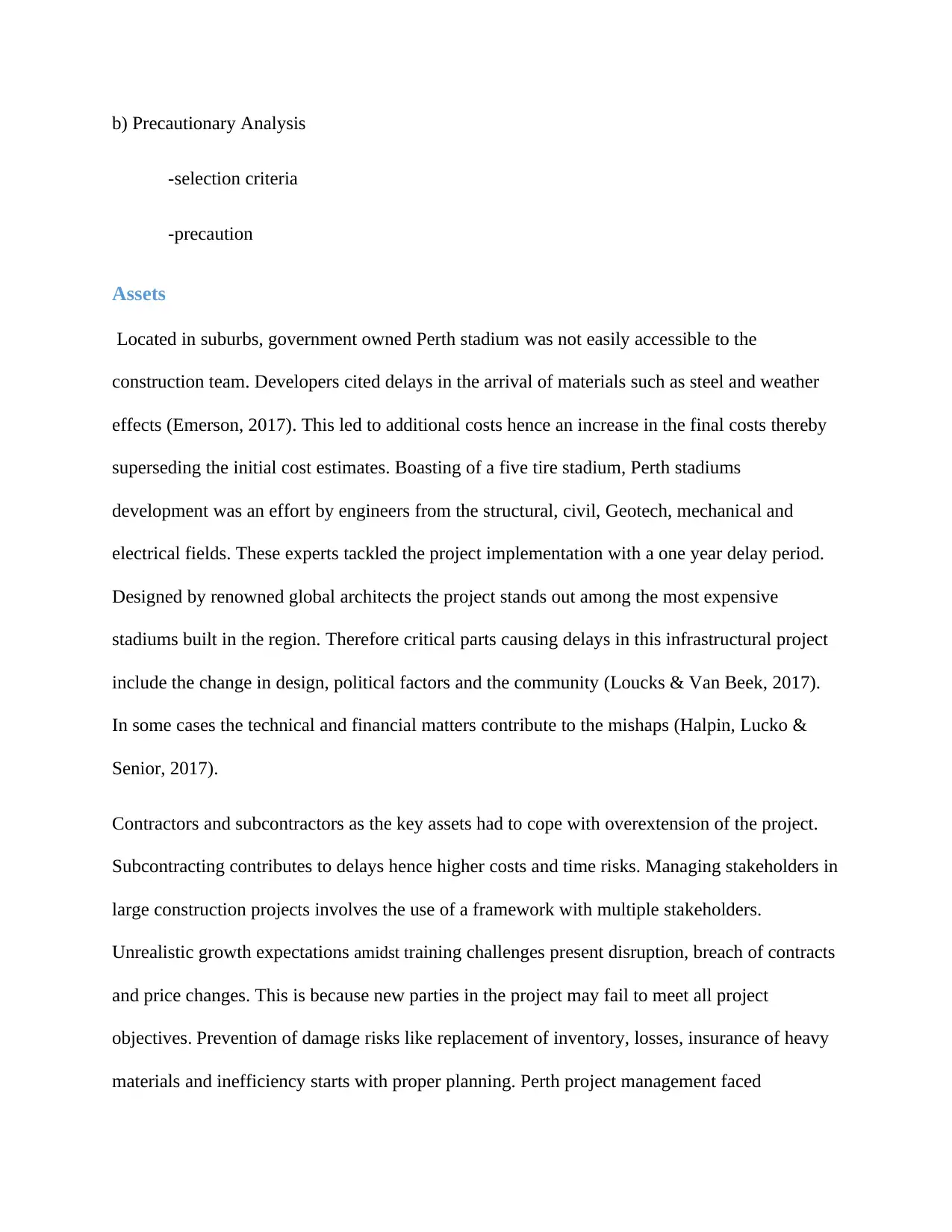
b) Precautionary Analysis
-selection criteria
-precaution
Assets
Located in suburbs, government owned Perth stadium was not easily accessible to the
construction team. Developers cited delays in the arrival of materials such as steel and weather
effects (Emerson, 2017). This led to additional costs hence an increase in the final costs thereby
superseding the initial cost estimates. Boasting of a five tire stadium, Perth stadiums
development was an effort by engineers from the structural, civil, Geotech, mechanical and
electrical fields. These experts tackled the project implementation with a one year delay period.
Designed by renowned global architects the project stands out among the most expensive
stadiums built in the region. Therefore critical parts causing delays in this infrastructural project
include the change in design, political factors and the community (Loucks & Van Beek, 2017).
In some cases the technical and financial matters contribute to the mishaps (Halpin, Lucko &
Senior, 2017).
Contractors and subcontractors as the key assets had to cope with overextension of the project.
Subcontracting contributes to delays hence higher costs and time risks. Managing stakeholders in
large construction projects involves the use of a framework with multiple stakeholders.
Unrealistic growth expectations amidst training challenges present disruption, breach of contracts
and price changes. This is because new parties in the project may fail to meet all project
objectives. Prevention of damage risks like replacement of inventory, losses, insurance of heavy
materials and inefficiency starts with proper planning. Perth project management faced
-selection criteria
-precaution
Assets
Located in suburbs, government owned Perth stadium was not easily accessible to the
construction team. Developers cited delays in the arrival of materials such as steel and weather
effects (Emerson, 2017). This led to additional costs hence an increase in the final costs thereby
superseding the initial cost estimates. Boasting of a five tire stadium, Perth stadiums
development was an effort by engineers from the structural, civil, Geotech, mechanical and
electrical fields. These experts tackled the project implementation with a one year delay period.
Designed by renowned global architects the project stands out among the most expensive
stadiums built in the region. Therefore critical parts causing delays in this infrastructural project
include the change in design, political factors and the community (Loucks & Van Beek, 2017).
In some cases the technical and financial matters contribute to the mishaps (Halpin, Lucko &
Senior, 2017).
Contractors and subcontractors as the key assets had to cope with overextension of the project.
Subcontracting contributes to delays hence higher costs and time risks. Managing stakeholders in
large construction projects involves the use of a framework with multiple stakeholders.
Unrealistic growth expectations amidst training challenges present disruption, breach of contracts
and price changes. This is because new parties in the project may fail to meet all project
objectives. Prevention of damage risks like replacement of inventory, losses, insurance of heavy
materials and inefficiency starts with proper planning. Perth project management faced
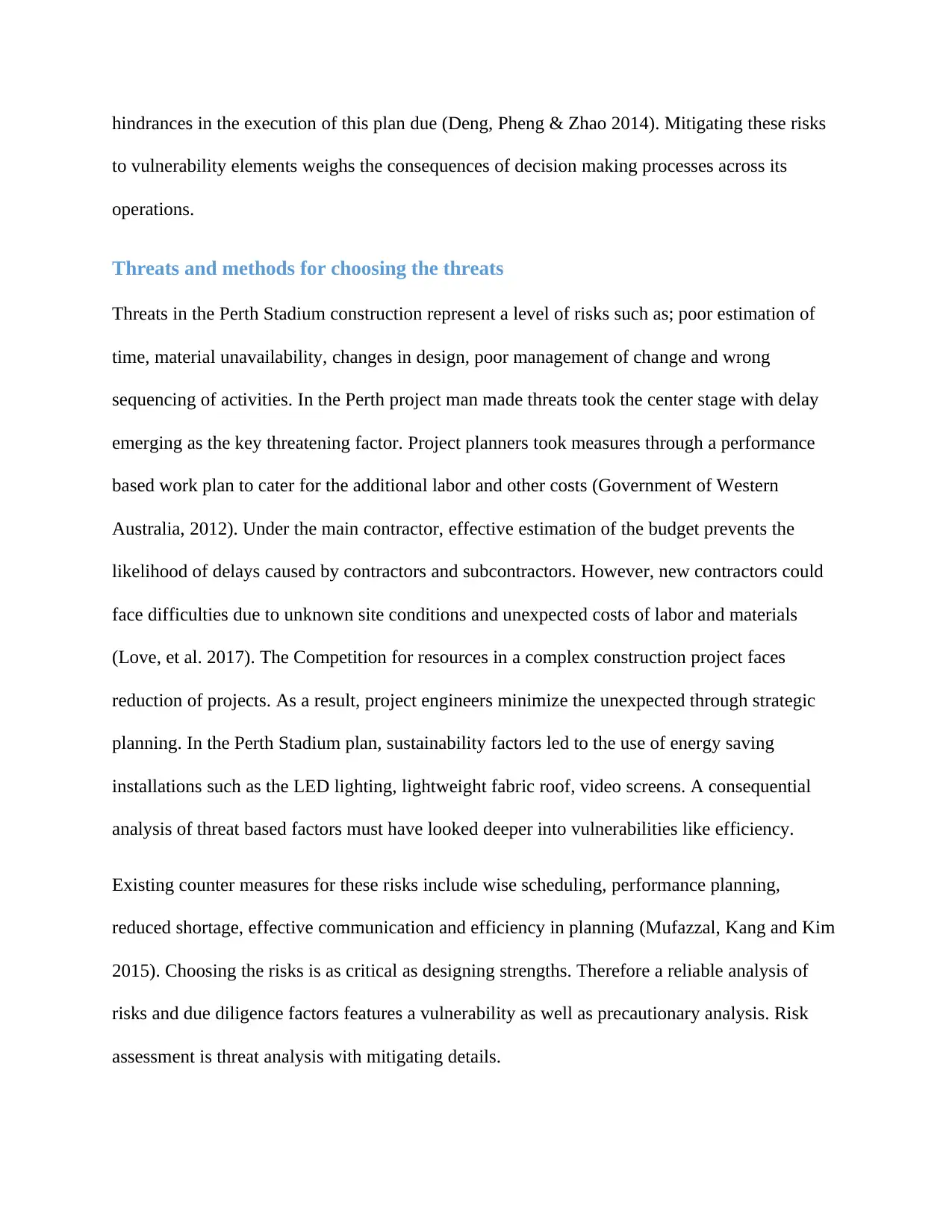
hindrances in the execution of this plan due (Deng, Pheng & Zhao 2014). Mitigating these risks
to vulnerability elements weighs the consequences of decision making processes across its
operations.
Threats and methods for choosing the threats
Threats in the Perth Stadium construction represent a level of risks such as; poor estimation of
time, material unavailability, changes in design, poor management of change and wrong
sequencing of activities. In the Perth project man made threats took the center stage with delay
emerging as the key threatening factor. Project planners took measures through a performance
based work plan to cater for the additional labor and other costs (Government of Western
Australia, 2012). Under the main contractor, effective estimation of the budget prevents the
likelihood of delays caused by contractors and subcontractors. However, new contractors could
face difficulties due to unknown site conditions and unexpected costs of labor and materials
(Love, et al. 2017). The Competition for resources in a complex construction project faces
reduction of projects. As a result, project engineers minimize the unexpected through strategic
planning. In the Perth Stadium plan, sustainability factors led to the use of energy saving
installations such as the LED lighting, lightweight fabric roof, video screens. A consequential
analysis of threat based factors must have looked deeper into vulnerabilities like efficiency.
Existing counter measures for these risks include wise scheduling, performance planning,
reduced shortage, effective communication and efficiency in planning (Mufazzal, Kang and Kim
2015). Choosing the risks is as critical as designing strengths. Therefore a reliable analysis of
risks and due diligence factors features a vulnerability as well as precautionary analysis. Risk
assessment is threat analysis with mitigating details.
to vulnerability elements weighs the consequences of decision making processes across its
operations.
Threats and methods for choosing the threats
Threats in the Perth Stadium construction represent a level of risks such as; poor estimation of
time, material unavailability, changes in design, poor management of change and wrong
sequencing of activities. In the Perth project man made threats took the center stage with delay
emerging as the key threatening factor. Project planners took measures through a performance
based work plan to cater for the additional labor and other costs (Government of Western
Australia, 2012). Under the main contractor, effective estimation of the budget prevents the
likelihood of delays caused by contractors and subcontractors. However, new contractors could
face difficulties due to unknown site conditions and unexpected costs of labor and materials
(Love, et al. 2017). The Competition for resources in a complex construction project faces
reduction of projects. As a result, project engineers minimize the unexpected through strategic
planning. In the Perth Stadium plan, sustainability factors led to the use of energy saving
installations such as the LED lighting, lightweight fabric roof, video screens. A consequential
analysis of threat based factors must have looked deeper into vulnerabilities like efficiency.
Existing counter measures for these risks include wise scheduling, performance planning,
reduced shortage, effective communication and efficiency in planning (Mufazzal, Kang and Kim
2015). Choosing the risks is as critical as designing strengths. Therefore a reliable analysis of
risks and due diligence factors features a vulnerability as well as precautionary analysis. Risk
assessment is threat analysis with mitigating details.
⊘ This is a preview!⊘
Do you want full access?
Subscribe today to unlock all pages.

Trusted by 1+ million students worldwide

Threat barrier diagram
This threat barrier diagram below shows the delay factor followed by its high frequency of
occurrence. The risk assessment highlights each of the factors for severity. There are solutions
for a wide range of solutions. Integrating operational measures through an effect analysis is
reliable. The conceptualization of the solution should start at the preliminaries for a schematic
design (Beccari, 2016). A cost effective analysis of the budget could have prevented excessive
spending in the Perth Stadium case. In this diagram the system clearly identifies the threats
which cause delays. The client case profile in this case is Perth Stadium. Assessing the delay risk
with its vulnerable areas determines its impact. In summary, the diagram formulates that:
Risk=Threat x Vulnerability x Impact
Figure 1: Risk Assessment plan (Adopted from: KCPT 2019)
Critical
assets to
protect
-Financial
-Time
Potential
threats
-Performance
-Quality
Delay
High risk occurrence
Vulnerability
Contractors &
Subcontractors
Impact
-12 months delay
-Over $ 10 million excess
costs
Risk Profile
Perth
Stadium
This threat barrier diagram below shows the delay factor followed by its high frequency of
occurrence. The risk assessment highlights each of the factors for severity. There are solutions
for a wide range of solutions. Integrating operational measures through an effect analysis is
reliable. The conceptualization of the solution should start at the preliminaries for a schematic
design (Beccari, 2016). A cost effective analysis of the budget could have prevented excessive
spending in the Perth Stadium case. In this diagram the system clearly identifies the threats
which cause delays. The client case profile in this case is Perth Stadium. Assessing the delay risk
with its vulnerable areas determines its impact. In summary, the diagram formulates that:
Risk=Threat x Vulnerability x Impact
Figure 1: Risk Assessment plan (Adopted from: KCPT 2019)
Critical
assets to
protect
-Financial
-Time
Potential
threats
-Performance
-Quality
Delay
High risk occurrence
Vulnerability
Contractors &
Subcontractors
Impact
-12 months delay
-Over $ 10 million excess
costs
Risk Profile
Perth
Stadium
Paraphrase This Document
Need a fresh take? Get an instant paraphrase of this document with our AI Paraphraser

Critical vulnerabilities
The New Perth Stadium project answered the questions; what? When? How? But failed to answer the
question What if? (Government of Western Australia, 2012, p,9). In this analysis the critical
vulnerabilities include the costs and time. The expected costs were $1 billion and the expected completion
time was late 2017. The task force had to engage subcontractors who comprised of; contract suppliers,
process management, logistics, and manufacturing team. Therefore the resilience to delays was at
different team work levels. A comprehensive use of variables through a ranking process for performance
influences change shows controls such as the elimination of subs contractors based on performance
challenges. The table below ranks the vulnerabilities according to priorities.
Figure 2: Ranking Vulnerabilities according to priorities
V.
high
High
Moderate
Low
Mitigate
hazard soon
Implement as soon
as possible
Unacceptable hazards
Acceptable
risk
The New Perth Stadium project answered the questions; what? When? How? But failed to answer the
question What if? (Government of Western Australia, 2012, p,9). In this analysis the critical
vulnerabilities include the costs and time. The expected costs were $1 billion and the expected completion
time was late 2017. The task force had to engage subcontractors who comprised of; contract suppliers,
process management, logistics, and manufacturing team. Therefore the resilience to delays was at
different team work levels. A comprehensive use of variables through a ranking process for performance
influences change shows controls such as the elimination of subs contractors based on performance
challenges. The table below ranks the vulnerabilities according to priorities.
Figure 2: Ranking Vulnerabilities according to priorities
V.
high
High
Moderate
Low
Mitigate
hazard soon
Implement as soon
as possible
Unacceptable hazards
Acceptable
risk
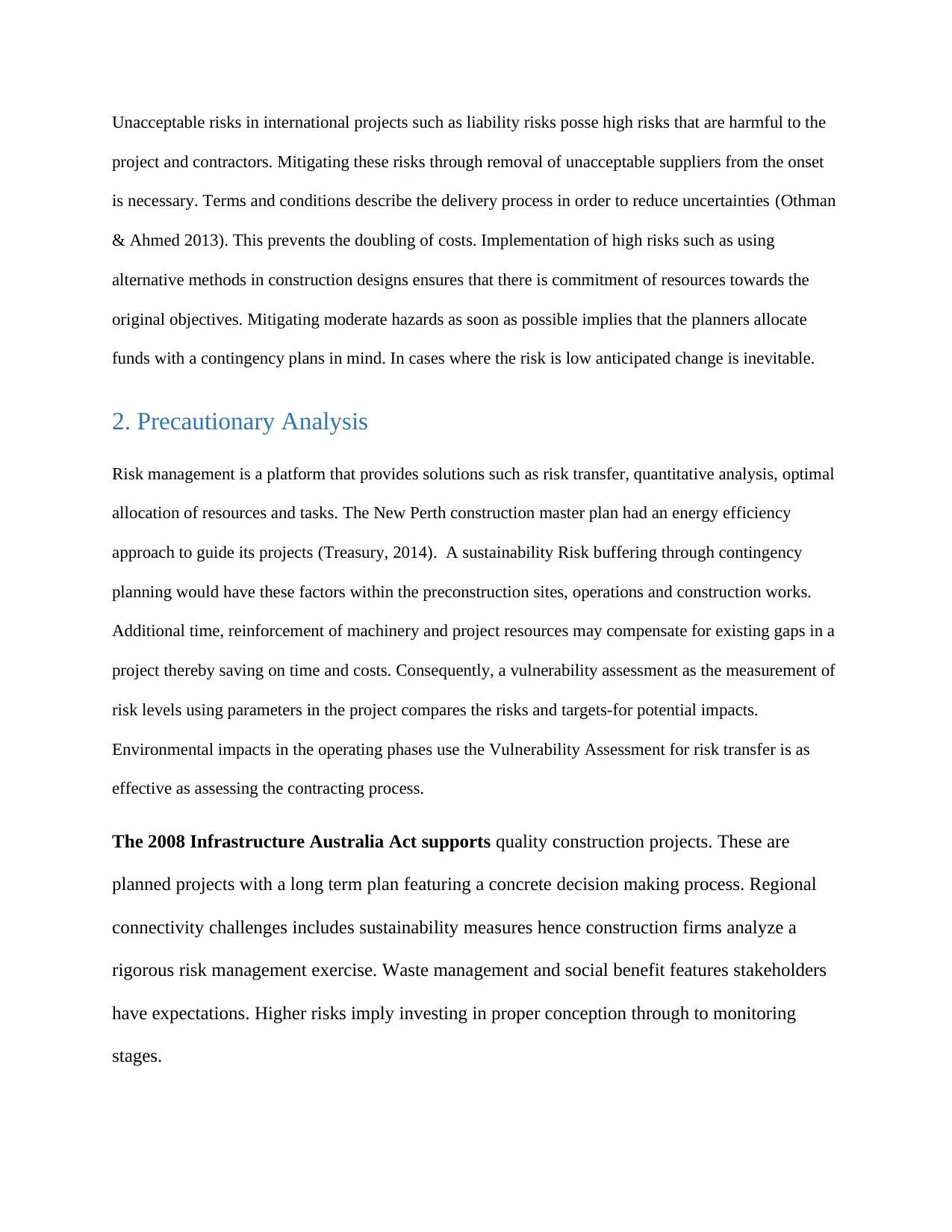
Unacceptable risks in international projects such as liability risks posse high risks that are harmful to the
project and contractors. Mitigating these risks through removal of unacceptable suppliers from the onset
is necessary. Terms and conditions describe the delivery process in order to reduce uncertainties (Othman
& Ahmed 2013). This prevents the doubling of costs. Implementation of high risks such as using
alternative methods in construction designs ensures that there is commitment of resources towards the
original objectives. Mitigating moderate hazards as soon as possible implies that the planners allocate
funds with a contingency plans in mind. In cases where the risk is low anticipated change is inevitable.
2. Precautionary Analysis
Risk management is a platform that provides solutions such as risk transfer, quantitative analysis, optimal
allocation of resources and tasks. The New Perth construction master plan had an energy efficiency
approach to guide its projects (Treasury, 2014). A sustainability Risk buffering through contingency
planning would have these factors within the preconstruction sites, operations and construction works.
Additional time, reinforcement of machinery and project resources may compensate for existing gaps in a
project thereby saving on time and costs. Consequently, a vulnerability assessment as the measurement of
risk levels using parameters in the project compares the risks and targets-for potential impacts.
Environmental impacts in the operating phases use the Vulnerability Assessment for risk transfer is as
effective as assessing the contracting process.
The 2008 Infrastructure Australia Act supports quality construction projects. These are
planned projects with a long term plan featuring a concrete decision making process. Regional
connectivity challenges includes sustainability measures hence construction firms analyze a
rigorous risk management exercise. Waste management and social benefit features stakeholders
have expectations. Higher risks imply investing in proper conception through to monitoring
stages.
project and contractors. Mitigating these risks through removal of unacceptable suppliers from the onset
is necessary. Terms and conditions describe the delivery process in order to reduce uncertainties (Othman
& Ahmed 2013). This prevents the doubling of costs. Implementation of high risks such as using
alternative methods in construction designs ensures that there is commitment of resources towards the
original objectives. Mitigating moderate hazards as soon as possible implies that the planners allocate
funds with a contingency plans in mind. In cases where the risk is low anticipated change is inevitable.
2. Precautionary Analysis
Risk management is a platform that provides solutions such as risk transfer, quantitative analysis, optimal
allocation of resources and tasks. The New Perth construction master plan had an energy efficiency
approach to guide its projects (Treasury, 2014). A sustainability Risk buffering through contingency
planning would have these factors within the preconstruction sites, operations and construction works.
Additional time, reinforcement of machinery and project resources may compensate for existing gaps in a
project thereby saving on time and costs. Consequently, a vulnerability assessment as the measurement of
risk levels using parameters in the project compares the risks and targets-for potential impacts.
Environmental impacts in the operating phases use the Vulnerability Assessment for risk transfer is as
effective as assessing the contracting process.
The 2008 Infrastructure Australia Act supports quality construction projects. These are
planned projects with a long term plan featuring a concrete decision making process. Regional
connectivity challenges includes sustainability measures hence construction firms analyze a
rigorous risk management exercise. Waste management and social benefit features stakeholders
have expectations. Higher risks imply investing in proper conception through to monitoring
stages.
⊘ This is a preview!⊘
Do you want full access?
Subscribe today to unlock all pages.

Trusted by 1+ million students worldwide
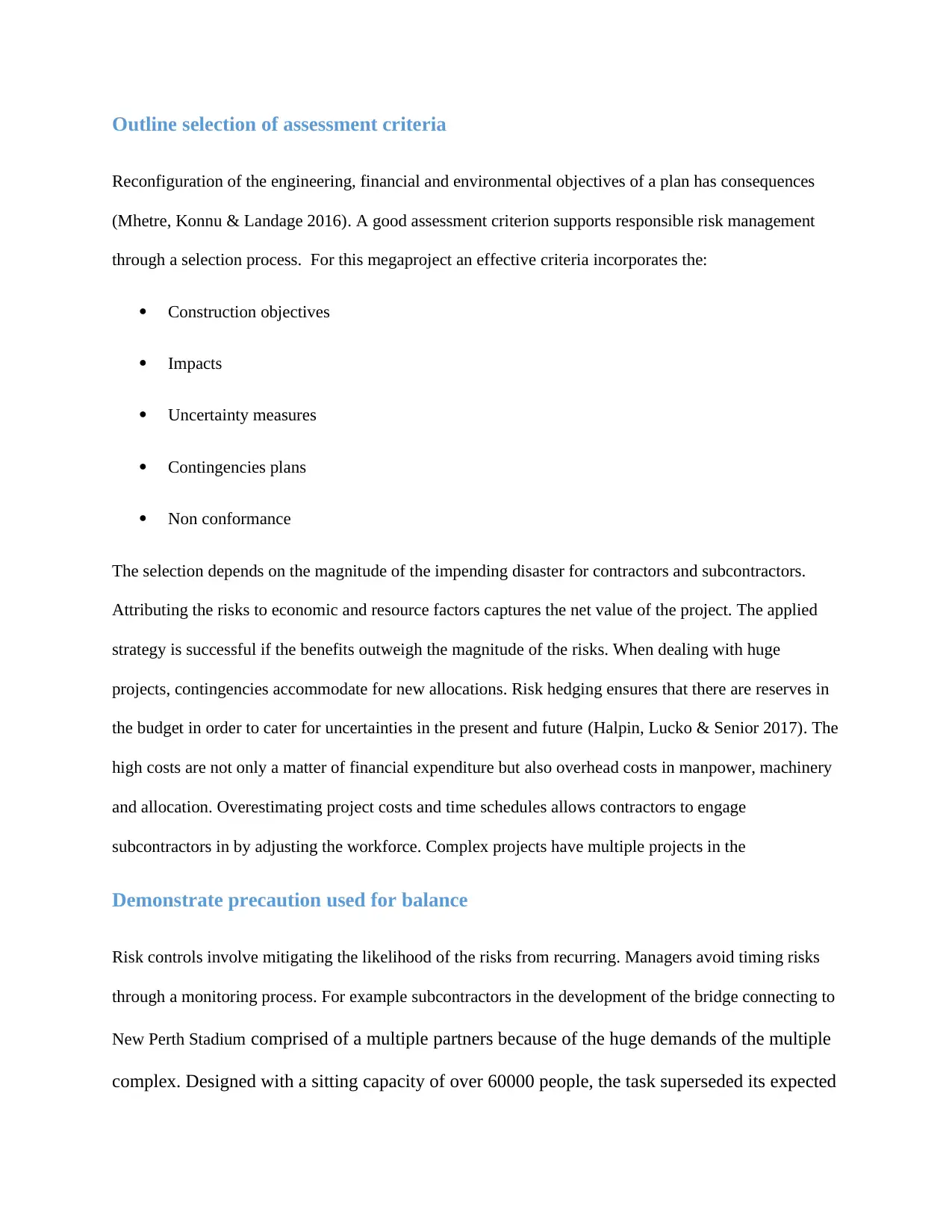
Outline selection of assessment criteria
Reconfiguration of the engineering, financial and environmental objectives of a plan has consequences
(Mhetre, Konnu & Landage 2016). A good assessment criterion supports responsible risk management
through a selection process. For this megaproject an effective criteria incorporates the:
Construction objectives
Impacts
Uncertainty measures
Contingencies plans
Non conformance
The selection depends on the magnitude of the impending disaster for contractors and subcontractors.
Attributing the risks to economic and resource factors captures the net value of the project. The applied
strategy is successful if the benefits outweigh the magnitude of the risks. When dealing with huge
projects, contingencies accommodate for new allocations. Risk hedging ensures that there are reserves in
the budget in order to cater for uncertainties in the present and future (Halpin, Lucko & Senior 2017). The
high costs are not only a matter of financial expenditure but also overhead costs in manpower, machinery
and allocation. Overestimating project costs and time schedules allows contractors to engage
subcontractors in by adjusting the workforce. Complex projects have multiple projects in the
Demonstrate precaution used for balance
Risk controls involve mitigating the likelihood of the risks from recurring. Managers avoid timing risks
through a monitoring process. For example subcontractors in the development of the bridge connecting to
New Perth Stadium comprised of a multiple partners because of the huge demands of the multiple
complex. Designed with a sitting capacity of over 60000 people, the task superseded its expected
Reconfiguration of the engineering, financial and environmental objectives of a plan has consequences
(Mhetre, Konnu & Landage 2016). A good assessment criterion supports responsible risk management
through a selection process. For this megaproject an effective criteria incorporates the:
Construction objectives
Impacts
Uncertainty measures
Contingencies plans
Non conformance
The selection depends on the magnitude of the impending disaster for contractors and subcontractors.
Attributing the risks to economic and resource factors captures the net value of the project. The applied
strategy is successful if the benefits outweigh the magnitude of the risks. When dealing with huge
projects, contingencies accommodate for new allocations. Risk hedging ensures that there are reserves in
the budget in order to cater for uncertainties in the present and future (Halpin, Lucko & Senior 2017). The
high costs are not only a matter of financial expenditure but also overhead costs in manpower, machinery
and allocation. Overestimating project costs and time schedules allows contractors to engage
subcontractors in by adjusting the workforce. Complex projects have multiple projects in the
Demonstrate precaution used for balance
Risk controls involve mitigating the likelihood of the risks from recurring. Managers avoid timing risks
through a monitoring process. For example subcontractors in the development of the bridge connecting to
New Perth Stadium comprised of a multiple partners because of the huge demands of the multiple
complex. Designed with a sitting capacity of over 60000 people, the task superseded its expected
Paraphrase This Document
Need a fresh take? Get an instant paraphrase of this document with our AI Paraphraser
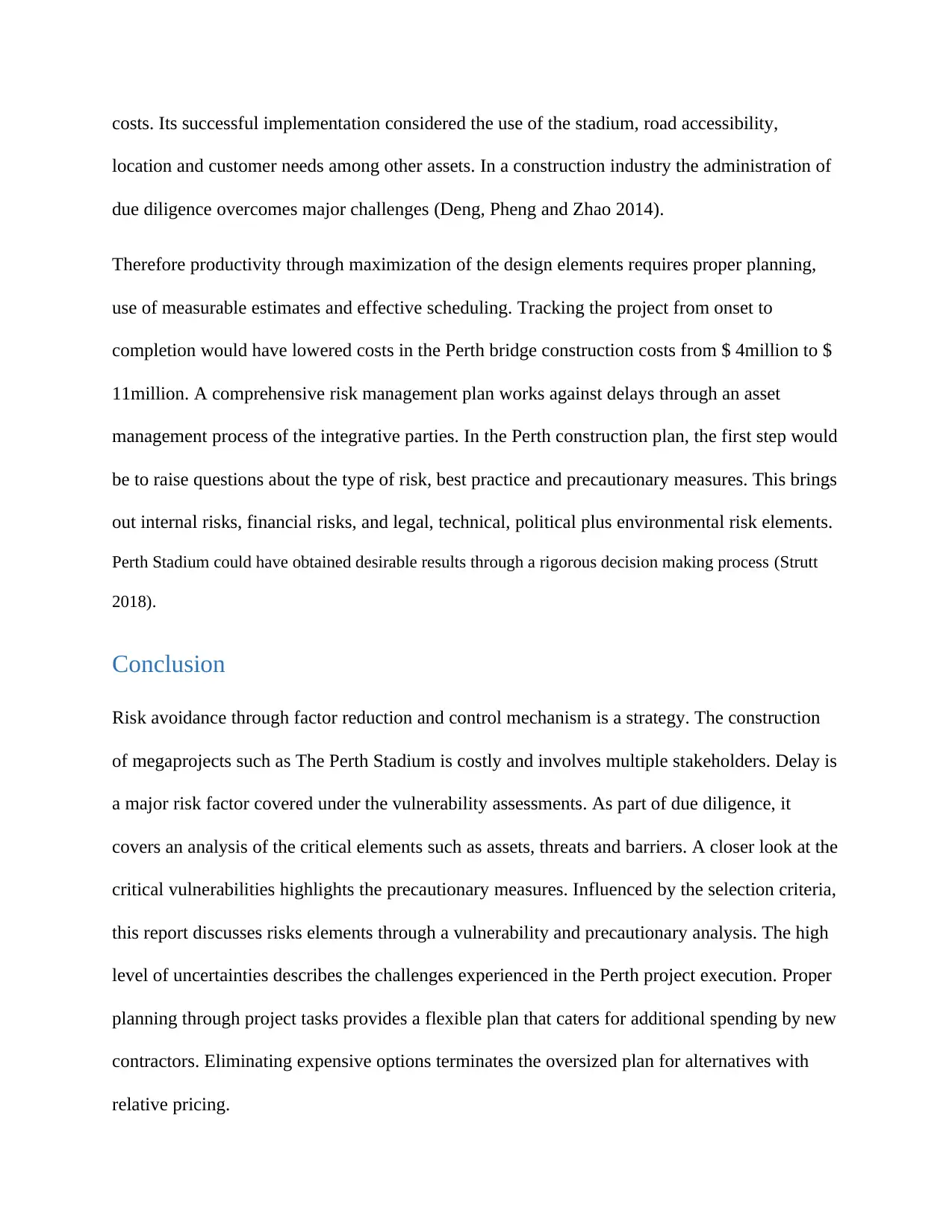
costs. Its successful implementation considered the use of the stadium, road accessibility,
location and customer needs among other assets. In a construction industry the administration of
due diligence overcomes major challenges (Deng, Pheng and Zhao 2014).
Therefore productivity through maximization of the design elements requires proper planning,
use of measurable estimates and effective scheduling. Tracking the project from onset to
completion would have lowered costs in the Perth bridge construction costs from $ 4million to $
11million. A comprehensive risk management plan works against delays through an asset
management process of the integrative parties. In the Perth construction plan, the first step would
be to raise questions about the type of risk, best practice and precautionary measures. This brings
out internal risks, financial risks, and legal, technical, political plus environmental risk elements.
Perth Stadium could have obtained desirable results through a rigorous decision making process (Strutt
2018).
Conclusion
Risk avoidance through factor reduction and control mechanism is a strategy. The construction
of megaprojects such as The Perth Stadium is costly and involves multiple stakeholders. Delay is
a major risk factor covered under the vulnerability assessments. As part of due diligence, it
covers an analysis of the critical elements such as assets, threats and barriers. A closer look at the
critical vulnerabilities highlights the precautionary measures. Influenced by the selection criteria,
this report discusses risks elements through a vulnerability and precautionary analysis. The high
level of uncertainties describes the challenges experienced in the Perth project execution. Proper
planning through project tasks provides a flexible plan that caters for additional spending by new
contractors. Eliminating expensive options terminates the oversized plan for alternatives with
relative pricing.
location and customer needs among other assets. In a construction industry the administration of
due diligence overcomes major challenges (Deng, Pheng and Zhao 2014).
Therefore productivity through maximization of the design elements requires proper planning,
use of measurable estimates and effective scheduling. Tracking the project from onset to
completion would have lowered costs in the Perth bridge construction costs from $ 4million to $
11million. A comprehensive risk management plan works against delays through an asset
management process of the integrative parties. In the Perth construction plan, the first step would
be to raise questions about the type of risk, best practice and precautionary measures. This brings
out internal risks, financial risks, and legal, technical, political plus environmental risk elements.
Perth Stadium could have obtained desirable results through a rigorous decision making process (Strutt
2018).
Conclusion
Risk avoidance through factor reduction and control mechanism is a strategy. The construction
of megaprojects such as The Perth Stadium is costly and involves multiple stakeholders. Delay is
a major risk factor covered under the vulnerability assessments. As part of due diligence, it
covers an analysis of the critical elements such as assets, threats and barriers. A closer look at the
critical vulnerabilities highlights the precautionary measures. Influenced by the selection criteria,
this report discusses risks elements through a vulnerability and precautionary analysis. The high
level of uncertainties describes the challenges experienced in the Perth project execution. Proper
planning through project tasks provides a flexible plan that caters for additional spending by new
contractors. Eliminating expensive options terminates the oversized plan for alternatives with
relative pricing.

Bibliography
Beccari, B. 2016. "A comparative analysis of disaster risk, vulnerability and resilience composite
indicators." PLoS Currents Accessed 22nd May 2019
<https://www.ncbi.nlm.nih.gov/pmc/articles/PMC4807925/>
Deng, X, L, S Pheng, and X Zhao. 2014."Project system vulnerability to political risks in
international construction projects: the case of Chinese contractors." Project Management 45, no.
2, pp, 20-33.
Emerson, D. 2017. "Optus stadium footbridge delayed after design change that could host
tourism climbs. November 2017." The West Australian, Accessed 22nd May 2019
<https://thewest.com.au/news/wa/optus-stadium-footbridge-delayed-after-design-change-that-
could-host-tourism-climbs-ng-b88669639z>
Government of Western Australia. 2012. The new Perth Stadium: Project Definition Plan.
Accessed 22nd May 2019 <file:///C:/Users/HP/Downloads/Project-Definition-Plan.pdf>.
Halpin, D, W, G Lucko, and B, A Senior. 2019. Construction Management. John Wiley & Sons
KCPT. 2019. Security & protective design consultancy. Accessed 22nd May
2019<http://www.kcpt.com.sg/security.php>
Loucks, D, P, and E Van Beek. 2017. Water resource systems planning and management: An
introduction to methods, models and applications. Springer.
Love, P, E, Z Irani, J Smith, M Regan, and J Liu. 2017. "Cost perfomance of public
infrastructure projects: the nemesis and nirvana of change orders." Production Planning &
Control 28, no. 13, Oct, 1081-1092.
Beccari, B. 2016. "A comparative analysis of disaster risk, vulnerability and resilience composite
indicators." PLoS Currents Accessed 22nd May 2019
<https://www.ncbi.nlm.nih.gov/pmc/articles/PMC4807925/>
Deng, X, L, S Pheng, and X Zhao. 2014."Project system vulnerability to political risks in
international construction projects: the case of Chinese contractors." Project Management 45, no.
2, pp, 20-33.
Emerson, D. 2017. "Optus stadium footbridge delayed after design change that could host
tourism climbs. November 2017." The West Australian, Accessed 22nd May 2019
<https://thewest.com.au/news/wa/optus-stadium-footbridge-delayed-after-design-change-that-
could-host-tourism-climbs-ng-b88669639z>
Government of Western Australia. 2012. The new Perth Stadium: Project Definition Plan.
Accessed 22nd May 2019 <file:///C:/Users/HP/Downloads/Project-Definition-Plan.pdf>.
Halpin, D, W, G Lucko, and B, A Senior. 2019. Construction Management. John Wiley & Sons
KCPT. 2019. Security & protective design consultancy. Accessed 22nd May
2019<http://www.kcpt.com.sg/security.php>
Loucks, D, P, and E Van Beek. 2017. Water resource systems planning and management: An
introduction to methods, models and applications. Springer.
Love, P, E, Z Irani, J Smith, M Regan, and J Liu. 2017. "Cost perfomance of public
infrastructure projects: the nemesis and nirvana of change orders." Production Planning &
Control 28, no. 13, Oct, 1081-1092.
⊘ This is a preview!⊘
Do you want full access?
Subscribe today to unlock all pages.

Trusted by 1+ million students worldwide
1 out of 13
Related Documents
Your All-in-One AI-Powered Toolkit for Academic Success.
+13062052269
info@desklib.com
Available 24*7 on WhatsApp / Email
![[object Object]](/_next/static/media/star-bottom.7253800d.svg)
Unlock your academic potential
Copyright © 2020–2025 A2Z Services. All Rights Reserved. Developed and managed by ZUCOL.



